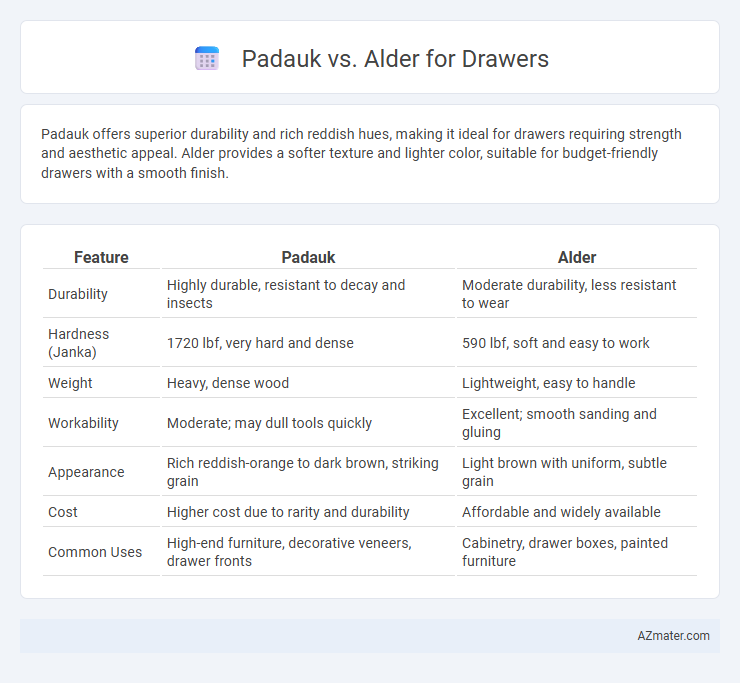Padauk offers superior durability and rich reddish hues, making it ideal for drawers requiring strength and aesthetic appeal. Alder provides a softer texture and lighter color, suitable for budget-friendly drawers with a smooth finish.
Table of Comparison
| Feature | Padauk | Alder |
|---|---|---|
| Durability | Highly durable, resistant to decay and insects | Moderate durability, less resistant to wear |
| Hardness (Janka) | 1720 lbf, very hard and dense | 590 lbf, soft and easy to work |
| Weight | Heavy, dense wood | Lightweight, easy to handle |
| Workability | Moderate; may dull tools quickly | Excellent; smooth sanding and gluing |
| Appearance | Rich reddish-orange to dark brown, striking grain | Light brown with uniform, subtle grain |
| Cost | Higher cost due to rarity and durability | Affordable and widely available |
| Common Uses | High-end furniture, decorative veneers, drawer fronts | Cabinetry, drawer boxes, painted furniture |
Overview of Padauk and Alder Woods
Padauk wood, known for its vibrant reddish-orange hue and high density, offers exceptional durability and resistance to decay, making it ideal for drawer construction requiring longevity and aesthetic appeal. Alder wood features a lighter, warm brown tone with a fine, consistent grain, providing a smooth finish and moderate hardness suited for furniture that balances cost and craftsmanship. Both woods excel in workability, with Padauk offering superior strength and Alder delivering ease of carving and staining for customizable drawer designs.
Key Differences Between Padauk and Alder
Padauk wood is known for its vibrant reddish-orange color and high durability, making it ideal for long-lasting, visually striking drawers. Alder wood features a softer texture and lighter, more muted brownish tones, providing a smooth finish but less resistance to wear. The key differences lie in Padauk's hardness and vivid color stability versus Alder's workability and subtle grain, impacting drawer longevity and aesthetic appeal.
Grain Patterns and Color Comparison
Padauk features striking, vibrant reddish-orange grain patterns that darken to a deep reddish-brown over time, offering a bold, eye-catching appearance for drawer fronts. Alder displays a consistent, straight grain with subtle variations in light brown to reddish-brown shades, providing a warm, neutral backdrop that complements various design styles. The contrast between Padauk's dynamic, vivid grains and Alder's smooth, understated texture makes them distinct choices depending on the desired visual impact and interior aesthetic.
Durability and Strength Considerations
Padauk wood offers exceptional durability and strength, making it highly resistant to wear, impact, and moisture, which is ideal for drawer construction in high-use environments. Alder wood, while softer and less dense, provides moderate strength and durability suitable for light to medium usage but may show dents and scratches more easily over time. When prioritizing long-lasting drawer performance with robust structural integrity, Padauk is the superior choice due to its harder, denser composition and natural resistance to damage.
Workability for Drawer Construction
Padauk offers superior workability for drawer construction due to its straight grain and moderate hardness, making it easier to cut, shape, and finish compared to alder. Alder, while softer and less dense, can sometimes be prone to dents and may require more careful handling to avoid damage during assembly. The consistent texture of padauk ensures smooth sanding and a durable finish, ideal for drawers subjected to frequent use.
Finishing and Maintenance Needs
Padauk wood offers a rich, reddish hue that darkens over time and requires regular oiling to maintain its vibrant color and prevent drying or cracking. Alder wood is lighter with a subtle grain, benefiting from clear finishes or stains to enhance its natural tone, and demands less frequent maintenance to preserve its smooth surface. Both woods respond well to sanding and finishing, but Padauk's higher oil content makes it slightly more resistant to moisture, requiring careful sealing to avoid finish discoloration.
Cost and Availability Factors
Padauk is generally more expensive than Alder due to its exotic origin and limited supply, which can impact project budgets significantly. Alder is widely available and cost-effective, making it a popular choice for drawer construction, especially in mass production. The higher cost and variable availability of Padauk may pose challenges for large-scale projects, while Alder's consistent supply ensures steady pricing and accessibility.
Environmental Impact and Sustainability
Padauk is a tropical hardwood known for its durability and vibrant reddish-orange hue, but it often faces sustainability concerns due to overharvesting in native African and Asian regions, leading to deforestation and habitat loss. Alder, a fast-growing hardwood native to North America, is considered a more sustainable option because it is typically sourced from managed forests with better regeneration rates and lower environmental impact. Choosing alder for drawer construction supports eco-friendly practices by reducing pressure on endangered tropical hardwood stocks and promoting responsible forest management.
Best Applications in Drawer Making
Padauk is ideal for drawer fronts and handles due to its vibrant reddish-orange color, high durability, and resistance to wear, making it perfect for visually striking, long-lasting pieces. Alder offers a softer, more workable texture with a light brown hue, suited for drawer bodies where ease of finishing and smooth gliding of drawers are priorities. Both woods excel in drawer making, with Padauk best for aesthetic-focused components and Alder optimal for structural elements requiring stability and smooth operation.
Final Recommendations: Padauk vs. Alder for Drawers
Padauk offers exceptional durability and rich reddish hues, making it ideal for high-traffic drawer use requiring strength and vibrant color retention. Alder is softer with a lighter tone, suitable for decorative drawers where ease of machining and a smooth finish are priorities. For long-lasting drawer functionality, Padauk is recommended, while Alder suits applications prioritizing cost-effectiveness and aesthetic subtlety.

Infographic: Padauk vs Alder for Drawer
 azmater.com
azmater.com